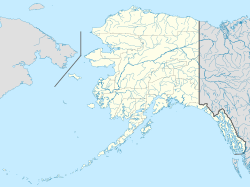Nightmute, Alaska facts for kids
Quick facts for kids
Nightmute
Negtemiut / Negta
|
|
|---|---|
| Country | United States |
| State | Alaska |
| Census Area | Bethel |
| Incorporated | April 30, 1974 |
| Area | |
| • Total | 104.39 sq mi (270.38 km2) |
| • Land | 98.96 sq mi (256.30 km2) |
| • Water | 5.43 sq mi (14.08 km2) |
| Elevation | 75 ft (23 m) |
| Population
(2020)
|
|
| • Total | 306 |
| • Density | 3.09/sq mi (1.19/km2) |
| Time zone | UTC-9 (Alaska (AKST)) |
| • Summer (DST) | UTC-8 (AKDT) |
| ZIP code |
99690
|
| Area code | 907 |
| FIPS code | 02-53930 |
| GNIS feature ID | 1407008, 2419433 |
Nightmute is a small city and village in Bethel Census Area, Alaska, United States. Its name in the local Yup'ik language is Central Yupik: Negtemiut or Negta. In 2020, about 306 people lived there.
Contents
History of Nightmute
The name Negtemiut means ‘the people of the pressed-down place’. This comes from the Yup'ik word negte-, which means ‘to press down on’. The suffix -miut means ‘people’.
Nightmute first appeared on the U.S. Census in 1940. Back then, it was called "Nigtmuit". Over the years, the spelling changed. It was "Nigtmute" in the 1950s and 1960s. By 1970, it became "Nightmute". The village officially became a city in 1974.
In 1964, many people from Nightmute moved. They traveled by dogsled to start a new community. This new place was Toksook Bay, about 15 miles (24 km) downriver. They moved to avoid having to travel between Umkumiut and Nightmute every spring and winter.
Geography of Nightmute
Nightmute is located on Nelson Island. It is close to another village called Toksook Bay. In winter, people can travel between the two villages using snowmachines.
The city covers a total area of about 101.5 square miles (262.9 km²). Most of this area, about 97.0 square miles (251.2 km²), is land. The remaining 4.5 square miles (11.7 km²) is water. Nightmute is located 15 to 17 miles east of Toksook Bay.
Nightmute's Population
The population of Nightmute has changed over the years. Here's a quick look at how many people have lived there:
- 1940: 78 people
- 1950: 27 people
- 1960: 237 people
- 1970: 127 people
- 1980: 119 people
- 1990: 153 people
- 2000: 208 people
- 2010: 280 people
- 2020: 306 people
In 2000, there were 208 people living in Nightmute. Most of the people were Native American, making up about 91.83% of the population. A smaller number were White or from two or more racial backgrounds.
Many households in Nightmute have children. In 2000, about 61.7% of homes had kids under 18. The average household had about 4 to 5 people. The median age of people in Nightmute was 22 years old. This means that half the population was younger than 22, and half was older. A large part of the population, about 41.3%, was under 18 years old.
Education in Nightmute
The main school in Nightmute is called Negtemiut Elitnaurviat School. It is also known as Nightmute School. This school is managed by the Lower Kuskokwim School District.
See also
 In Spanish: Nightmute para niños
In Spanish: Nightmute para niños


